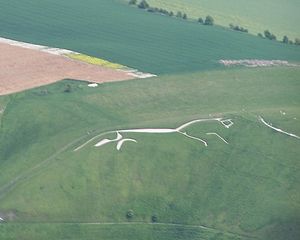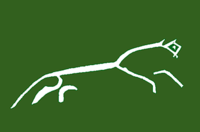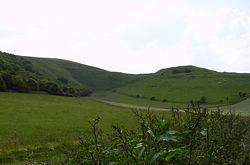Uffington White Horse
2008/9 Schools Wikipedia Selection. Related subjects: Ancient History, Classical History and Mythology
| Whitehorse Hill | |
|---|---|
 The White Horse as seen from an altitude of 700 metres |
|
| Elevation | 261 m (856 ft) |
| Location | Oxfordshire, England |
| Prominence | 79 m |
| Topo map | OS Landranger 174 |
| OS grid reference | SU301866 |
| Listing | County Top |
The Uffington White Horse is a highly stylised prehistoric hill figure, 374 feet (110 m) long, cut into the turf of the upper slopes of White Horse Hill in the English civil parish of Uffington ( Oxon, historically Berks). It is located some five miles south of the town of Faringdon and a similar distance west of the town of Wantage. The hill forms a part of the scarp of the Berkshire Downs and overlooks to Vale of White Horse to the north. Best views of the horse are obtained from directly across the Vale, particularly around the villages of Great Coxwell, Longcot and Fernham. The site is owned and managed by the National Trust.
History of the figure
The figure has been shown to date back some 3,000 years, to the Bronze Age, based on optically stimulated luminescence dating carried out following archaeological investigations in 1994. These studies produced three dates ranging between 1400 and 600 BC. Iron Age coins have been found that bear a representation of the Uffington White Horse, reinforcing the early dating of this artifact, thus further discounting alternative theories that the figure was created in the Early Middle Ages. Numerous other prominent prehistoric sites are located nearby, notably Wayland's Smithy, a long barrow less than two kilometres to the west. It is the only chalk figure in the United Kingdom that scientists generally accept as being truly "prehistoric."
It has long been debated whether the chalk figure is intended to represent a horse or some other animal. However, it has been called a horse since the eleventh century at least. An Abingdon cartulary, written by monks on vellum, between 1072 and 1084, refers to "mons albi equi" at Uffington ("the White Horse Hill").
The horse is thought to represent a tribal symbol perhaps connected with the builders of Uffington Castle. Due to the angle of the slope it is carved on, only a small part of the horse can be seen at a time by an observer standing on the ground, which indicates a religious or magical significance to the figure.
It is quite similar to horses depicted on pre-Roman British coinage and the Marlborough bucket. For centuries, however, local people have maintained that it is a portrait of the dragon slain by Saint George on the nearby Dragon Hill.
Up until the late 19th century the horse was scoured every seven years as part of a more general local fair held on the hill. However, when the regular cleaning is halted the figure quickly becomes obscured. It has always needed frequent work for the figure to remain visible.
Nearby features and recent events
The most significant nearby feature is the Iron Age Uffington Castle, located on higher ground atop a knoll above the White Horse. This hillfort comprises an area of approximately 3 hectares enclosed by a single, well preseved, bank and ditch.
To the west are ice-cut terraces known as the "Giant's Stair".
Some believe these terraces at the bottom of this valley are the result of medieval farming, or alternatively were used for early farming after being formed by natural processes. The steep sided dry valley below the horse is known as the Manger and legend says that the horse grazes there at night.
The Blowing Stone, a perforated sarsen stone, which lies in a garden in Kingston Lisle, two kilometres away and which produces a musical tone when blown through, is thought possibly to have been moved from the White Horse site, in the year 1750.
In August, 2002 the figure was defaced with the addition of a rider and three dogs by members of the "Real Countryside Alliance" (Real CA). The act was denounced by the Countryside Alliance.


